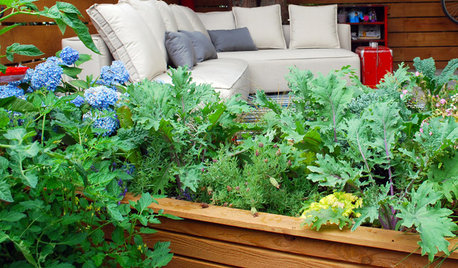An organic solution to cucumber beetles
anney
13 years ago
Related Stories

MORE ROOMS6 Garage Organizing Tips That Really Work
National Clean Out the Garage Day: Here's how to clear the clutter and organize what's left
Full Story
GARDENING GUIDESOrganic Matters: Thwart Insect Pests With Trap Crops
Add a few sacrificial plants to your garden to lure insects away from the harvest
Full Story
GARDENING GUIDESHow to Switch to an Organic Landscape Plan
Ditch the chemicals for a naturally beautiful lawn and garden, using living fertilizers and other nontoxic treatments
Full Story
EDIBLE GARDENSGarden BFFs? Why Your Vegetables Are Begging for Companion Plants
Foster friendships among plants for protection from pests, pollination support and color camaraderie
Full Story
GARDENING GUIDES6 Plants That Beat Butterfly Bush for the Wildlife Draw
It's invasive, a nonnative and a poor insect magnet. Check out these better alternatives to butterfly bush in the garden
Full Story
GARDENING GUIDESStep Right Outside for Fresh Herbs and Vegetables
Decks and patios can be convenient spots for edibles, and sometimes they even offer advantages over backyard gardens
Full Story
GARDENING GUIDESLush, Foodie Abundance in a Small Urban Garden
This modest backyard garden provides its owner with fruit and vegetables all year round, thanks to an innovative low-maintenance approach
Full Story
GARDENING GUIDESGarden Myths to Debunk as You Dig This Fall and Rest Over Winter
Termites hate wood mulch, don’t amend soil for trees, avoid gravel in planters — and more nuggets of garden wisdom
Full Story
GARDENING GUIDESTree Care: Common Tree Diseases and What to Do About Them
Learn to recognize trees that may be affected by diseases or pests so you can quickly take action
Full Story
GARDENING GUIDESTexas Gardener's May Checklist
Be especially water wise this month as you sow seeds, tend to your lawn and plant edibles, grasses and flowers
Full Story







borderbarb
anneyOriginal Author
Related Professionals
Rossville Landscape Architects & Landscape Designers · Amesbury Landscape Contractors · Mastic Beach Landscape Contractors · Seminole Landscape Contractors · University City Landscape Contractors · Waltham Landscape Contractors · New Carrollton Landscape Contractors · Green Bay Decks, Patios & Outdoor Enclosures · Hendersonville Decks, Patios & Outdoor Enclosures · Lancaster Decks, Patios & Outdoor Enclosures · Midlothian Decks, Patios & Outdoor Enclosures · Royal Oak Decks, Patios & Outdoor Enclosures · West Hills Decks, Patios & Outdoor Enclosures · Laguna Beach Stone, Pavers & Concrete · Melvindale Stone, Pavers & ConcreteKimmsr
anneyOriginal Author
Kimmsr
SerenitysHaven
cbfindlay
juliagoolia74
little_minnie